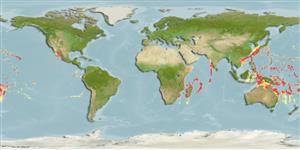>
Lophiiformes (Anglerfishes) >
Neoceratiidae (Toothed seadevils)
Etymology: Neoceratias: Named by Pappenheim (1914:198) to signify a new kind of ceratiid-like anglerfish, at the time expressing uncertainty of its position within the suborder but finding great similarity with the Ceratiidae. (Ref. 86949).
Environment: milieu / climate zone / depth range / distribution range
Sinh thái học
Biển gần đáy; Mức độ sâu 0 - 1200 m (Ref. 58302). Deep-water
Western Central Pacific.
Bộ gần gũi / Khối lượng (Trọng lượng) / Age
Maturity: Lm ? range ? - ? cm
Max length : 6.0 cm TL con đực/không giới tính; (Ref. 557)
Short description
Hình thái học | Sinh trắc học
Các vây lưng mềm (tổng cộng): 10-13; Tia mềm vây hậu môn: 10 - 13. Metamorphosed females distinguished by the following characteristics: lacks illicium and second cephalic spine, as well as cranial trough, within which pterygiophore of illicium lies in all other female ceratioids; broad and roughly rectangular shaped frontals; absence of metapterygoid and mesopterygoid; usually short and nearly straight preopercle; usually thick and well developed premaxillae and dentaries, with rounded edges; presence of a pair of prominent nasal papillae on snout; inner margin of jaws bearing single inner row of small immobile teeth; outer margin bears 2-3 series of long hinged teeth, each with tiny distal hook; dorsal and anal fins mounted on prominent bases; presence of supraethmoid; frontals without ventromedial extensions, meet on midline; presence of parietals; conical shaped sphenotics, without distal spine; presence of pterosphenoid; hyomandibula with single head; 2 hypohyals and 6 (2+4), rarely 5 (1+4), branchiostegal rays; bifuctaed and very much reduced opercle; reduced subopercle, long and narrow, as long as or slightly longer than lower fork of opercle, without posterior notch; ventral part without spine or projection on anterior margin; quadrate, articular, angular and preopercular spines absent; jaws subequal, lower extending anteriorly beyond upper; lower jaw lacking symphisial spine; absence postmaxillary process of premaxilla and anterior-maximandibular ligament; absence of first, second and fourth pharyngobranchial, third is well developed and toothed; single ossified hypobranchial; absence of ossified basibranchials; absence of epibranchial and ceratobranchial; epurals absent; deeply notched posterior margin of hypural plate; pterygiophore of illicium fully embedded in skin of head; esca absent; coracoid lacking posteroventral process; 3 pectoral radials; small and cylindrical pelvic bones, without distal expansion; dorsal fin rays 10-13; anal fin rays 10-13; pectoral fin rays 12-15; pelvic fins absent (Ref. 86949).
Meso- (Ref 58302) and bathypelagic (Ref. 7300, 75154). Females with long movable teeth outside jaws. Mature males parasitic on females.
Life cycle and mating behavior
Chín muồi sinh dục | Sự tái sinh sản | Đẻ trứng | Các trứng | Sự sinh sản | Ấu trùng
Nelson, J.S., 1984. Fishes of the world. 2nd edition. John Wiley & Sons, Inc., New York. 523 p. (Ref. 245)
IUCN Red List Status (Ref. 130435)
Threat to humans
Harmless
Human uses
Các nghề cá: không ích lợi (thú vị)
Thêm thông tin
Age/SizeSự sinh trưởngLength-weightLength-lengthLength-frequenciesSinh trắc họcHình thái họcẤu trùngSự biến động ấu trùngBổ xungSự phong phúBRUVS
Các tài liệu tham khảoNuôi trồng thủy sảnTổng quan nuôi trồng thủy sảnCác giốngDi truyềnElectrophoresesDi sảnCác bệnhChế biếnNutrientsMass conversion
Các công cụ
Special reports
Download XML
Các nguồn internet
Estimates based on models
Preferred temperature (Ref.
123201): 8.3 - 20.1, mean 13 °C (based on 250 cells).
Phylogenetic diversity index (Ref.
82804): PD
50 = 1.5000 [Uniqueness, from 0.5 = low to 2.0 = high].
Bayesian length-weight: a=0.00389 (0.00180 - 0.00842), b=3.12 (2.94 - 3.30), in cm total length, based on all LWR estimates for this body shape (Ref.
93245).
Mức dinh dưỡng (Ref.
69278): 3.5 ±0.6 se; based on size and trophs of closest relatives
Fishing Vulnerability (Ref.
59153): Low vulnerability (10 of 100).
Nutrients (Ref.
124155): Calcium = 77.4 [30.7, 210.4] mg/100g; Iron = 0.678 [0.288, 1.403] mg/100g; Protein = 17.6 [15.0, 20.7] %; Omega3 = 0.571 [0.185, 1.583] g/100g; Selenium = 10.5 [3.4, 27.0] μg/100g; VitaminA = 69.1 [14.1, 370.3] μg/100g; Zinc = 0.611 [0.352, 1.033] mg/100g (wet weight);
